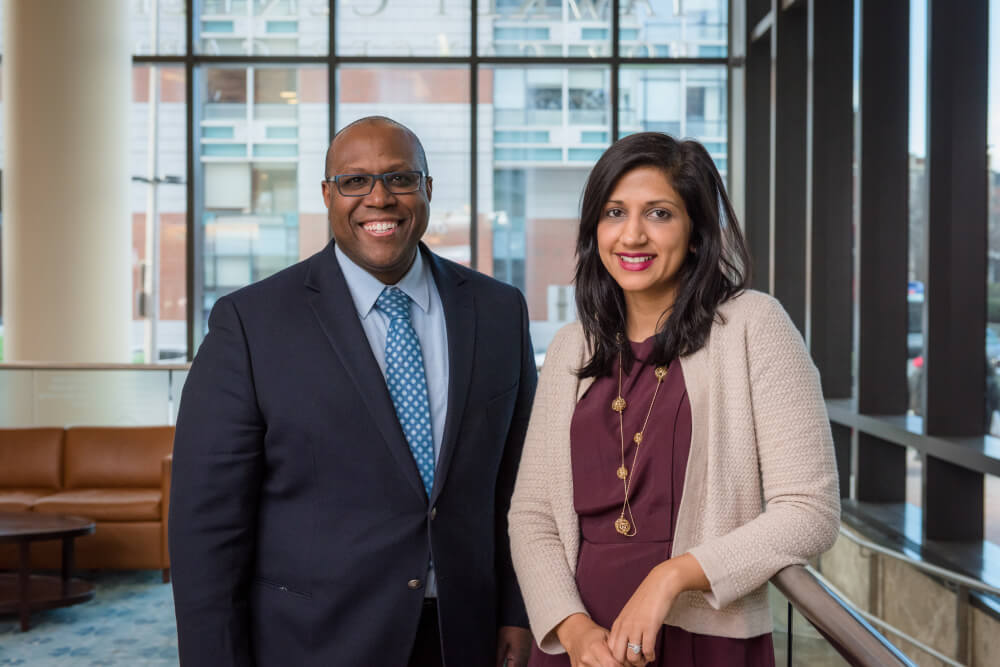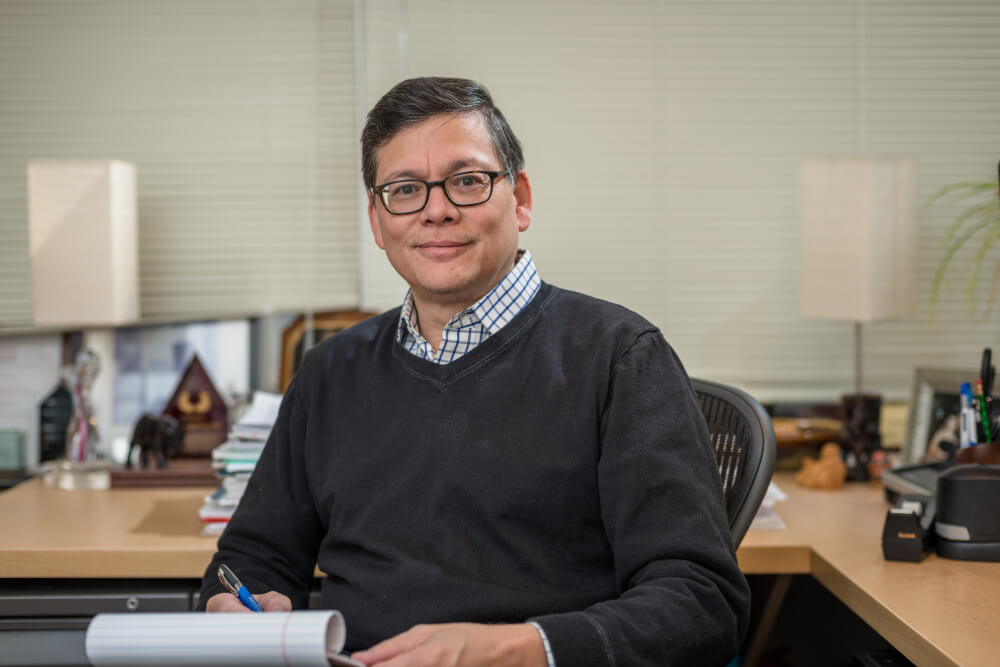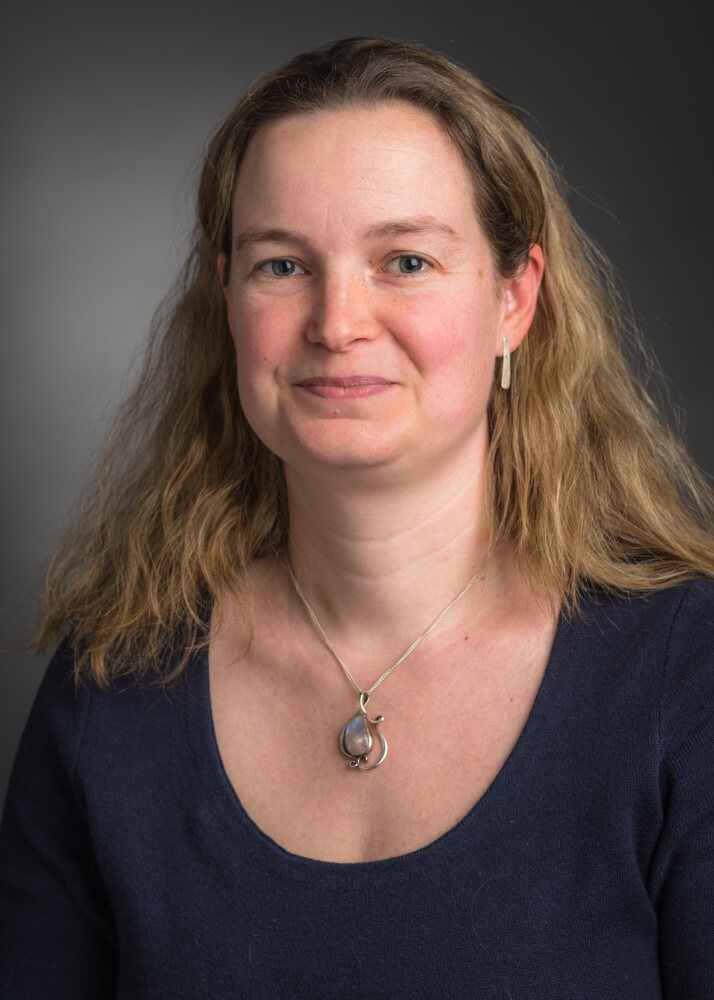- Cancer disproportionately affects many underserved groups, including Black Americans as well as people of low socioeconomic status.
- The reasons for this are complex and rooted in many different factors, including structural racism.
- Dana-Farber investigators have undertaken a range of studies to understand the causes of these inequalities and develop approaches to alleviating them.
Despite enormous advances in cancer treatment, some racial, ethnic, and socioeconomic groups still bear an especially large burden from the disease, with higher incidence rates for many cancers and poorer outcomes.
Decades of research has documented these disparities. Among adult patients, for example, African Americans have the highest mortality rate of any racial or ethnic group for all cancers combined, according to data from the U.S. Department of Health and Human Services Office of Minority Health. The risk of developing cancer is higher in Black than in white people for many cancers, particularly those associated with an infection, such as stomach, liver, or cervical cancer, according to the American Cancer Society (ACS).
“The causes of these inequalities are complex and reflect social and economic disparities and cultural differences that affect cancer risk, as well as differences in access to high-quality health care,” the ACS notes. “Structural racism — the combination of institutions, culture, history, ideology, and codified practices that generate and perpetuate inequity across racial and ethnic groups — also contributes to disparate health outcomes.”
The ACS notes that socioeconomic disparities result in unequal access to opportunities and resources, such as work, wealth, income, education, housing, healthy food, and overall standard of living. These factors and more can contribute to disparate outcomes.
As part of Dana-Farber’s mission to reduce the burden of cancer for all people, Institute researchers conduct a wide range of studies into the causes of cancer disparities and approaches to alleviating them. Dana-Farber investigators have worked in the lab, clinic, and the community to improve access to quality cancer care, heighten awareness of cancer risk and prevention, and improve treatment outcomes for Black, Latinx, and other people of color or underserved groups.
“Progress against cancer is meaningful only to the extent that it is shared equally — that no community is left behind,” says Dana-Farber President and CEO Laurie H. Glimcher, MD. “There is much to be done to reduce and ultimately eliminate cancer disparities in our society. But we are committed as an institution and as individuals to taking up the challenge of breaking down barriers and creating better access to lifesaving cancer care for all patients.”
What follows is a sampling of equity research and initiatives and is not comprehensive.
A different model of cancer care
Christopher Lathan, MD, MS, MPH, chief clinical access and equity officer and faculty director of the Cancer Care Equity Program (CCEP), has conducted a range of studies into the potential benefits of a community health center-based model of cancer care.
Lathan, who also serves as the Associate Chief Medical Officer and Director of the Dana-Farber Cancer Institute Network, and his team led a co-location model intervention for cancer diagnostic services at a federally qualified health center (FQHC) in Boston that serves a historically marginalized community of color. The CCEP team designed the program to bring oncology diagnostics and cancer-specific patient navigation services from Dana-Farber into the community health center.
In a recent review of outcomes at the diagnostic clinic, which has been in operation for 12 years, the intervention reduced time to cancer diagnosis from a median of 32 days to 12 days.

“The primary goal of this intervention was to decrease the time it took to complete cancer diagnoses,” said Lathan. “We got it down to 12 days, which was surprising and amazing.”
The CCEP team did not provide direct cancer treatment, but rather worked to help direct patients to the right next step, be it prevention services, diagnostic tests, or care at a treatment center. For instance, a patient in need of a scan might be directed to a local hospital with scanning capabilities or to Dana-Farber, depending on the patient’s history, preference, and insurance. The entire program was built with patient navigation as its foundation.
The model is now in operation in two other FQHCs in Boston and has evolved to include a physician assistant as well as a patient navigator and research team.
Huma Rana, MD, MPH, clinical director of Cancer Genetics and Prevention at Dana-Farber, is also leading community-outreach efforts related to genetic counseling. Dana-Farber genetic counselors are offering outreach clinics at several community health centers in the greater Boston area.
Addressing the impact of prostate cancer on Black men
Tim Rebbeck, PhD, focuses on the causes and prevention of cancers in which racial disparities are particularly pronounced — including prostate cancer, which has a higher incidence and mortality rate among Black men than white men.
Because prostate cancer is a complex disease, influenced by biology, social influences, and care, Rebbeck and his colleagues look for connections between multiple factors, including genetic and genomic influences on the disease’s onset and progression, with the goal of identifying interventions that will benefit all patients. Rebbeck is a leader of the Men of African Descent and Carcinoma of the Prostate (MADCaP) Network, which involves men of African descent in the U.S. and Africa and aims to better understand the complex causes and influences on prostate cancer among men of African ancestry.

“While incidence and mortality are both influenced by multiple factors, recent evidence suggests that the development of prostate cancer is influenced in part by genetics and screening, while the death rate is more strongly influenced by social and economic factors including access to health-care services,” Rebbeck states. “We’re investigating the interplay of these factors to improve outcomes worldwide.”
Recently, Rebbeck helped launch the Precision Care, Interventions, Screening, and Empowerment (PRECISE) Initiative, which is creating a model for identifying populations at increased risk for prostate cancer and tailoring screening recommendations for each group.
“The field of cancer disparities research is at a major inflection point,” Rebbeck says. “We now have good quality research in a variety of areas that provide strong evidence for the sources of disparities. It is clear that there are contributions from genetic and biological influences, social influences, lifestyle, behavior, and access to health care. The next major push in the field is to translate this knowledge into interventions that can begin to eliminate these disparities in the general population. This work will require we know when, how, and in whom we can intervene to maximize cancer health equity. Progress will require effective public health interventions as well as policy decisions.”
Liver cancer disparities
Liver cancer disproportionately affects people from racial and ethnic groups that are historically underserved in health care. Christopher Manz, MD, is interested in learning more about disparities in access to new treatments for the disease and developing strategies to improve equitable care for patients with liver cancer.
Prior to 2017, there were few systemic treatments for liver cancer. But since then, nine new medicines have been approved. Currently, little is known about who is receiving these new medicines. “These treatments may be improving outcomes for patients overall,” Manz remarks. “But we want to know if there are certain patient populations who are not benefitting from them because they are less likely to receive them.”
Manz will analyze data database of de-identified patient medical records that includes patients with diagnosis and treatment through 2023. The data is drawn from a range of clinical settings, providing a diverse representation of patients in terms of race, gender identity, age, insurance status, and location.
“The first question we want to answer is whether patients are equitably receiving these new medicines,” explains Manz. “If not, the next questions are ‘Why not?’ and ‘How can we improve care?’”
Socioeconomic disparities in childhood cancer
Kira Bona, MD, MPH, studies how poverty affects outcomes in children with cancer who are treated in clinical trials. Because cancer is much rarer in children than adults, the model of care differs significantly from that of adults, with a greater reliance on clinical trial-based care delivery. By analyzing data from completed multi-center trials, Bona and her colleagues have found that children living in poverty with childhood leukemia, and neuroblastoma are more likely to relapse and die of their disease – despite uniform planned treatment – and both children and their parents suffer greater distress when compared to those not living in poverty.

To address these disparities, Bona’s team is working to develop multiple poverty-targeted interventions with a goal of reducing disparities and improving childhood cancer outcomes. Bona and her team developed and piloted the Pediatric Cancer Resource Equity (PediCARE) intervention, the first poverty-targeted intervention for children with cancer, at Dana-Farber and the University of Alabama at Birmingham. They have found the program to be helpful to families and feasible to implement. With funding from the NIH, PediCARE will be evaluated as the first health equity intervention ever included in a clinical drug trial for children with cancer to assess whether it can successfully reduce disparities and improve outcomes.
Building on this success, Bona’s team has developed a second poverty-targeted intervention, Pediatric RISE, which provides cash to families living with low-income during the early months of a child’s chemotherapy treatment. RISE is currently being evaluated for feasibility in a randomized pilot study at DFCI and Columbia University. Next steps in this work will include evaluation of whether RISE can help to reduce disparities in a multi-center trial.
Bona’s research group also collaborates with laboratory scientists to explore whether the chronic stress of living in poverty results in physiologic changes that make cancer cells more resistant to chemotherapy or immunotherapy. Data from this research could result in better tailoring of therapy to individual patients.
Understanding social determinants of health
The Dana-Farber Patient Reported Data Program Medical Director Nadine McCleary, MD, MPH, is spearheading efforts to systematically capture information about the social determinants of health for all patients at Dana-Farber. Her efforts will help the Institute identify the resources and support services to help all patients achieve the best possible outcomes.
Raising awareness of and access to cancer prevention
Dana-Farber researcher Vish Viswanath, PhD, conducts a wide range of research into cancer prevention, including ensuring that potential ways to reduce cancer risk are accessible to everyone.
According to Viswanath, approximately 50-60% of cancers can be prevented predominantly by reducing behaviors that increase cancer risk, such as tobacco use, and through cancer screening.
“That’s a non-trivial number,” says Viswanath. “But knowing what to do to reduce your risk depends on whether or not you have access to information about risk reduction.”
To reach more people, and to reach people via channels that will inspire trust and garner attention, Viswanath is focused on community engaged research. He and his team partner with the community to learn more about a community’s knowledge and understanding of risk, and to develop ways to provide helpful information. His team, for instance, has worked with labor unions to understand risk behaviors of including smoking and how to stop using tobacco. Such information will help them develop effective interventions.
“Instead of thinking that people in our communities are ‘hard to reach,’ we think of them as ‘hardly reached,’” says Viswanath. “Our focus is to find ways to reach them that are effective.”
His team is currently working with the Mayor’s Health Task Force in Lawrence, Mass., to reach young people. This partnership, which builds on 18 previous years of partnerships in this community, focuses on first learning what young people think about health, what cancer-related misinformation they are receiving, and how they communicate and learn about health.
“Attitudes, knowledge, and behaviors that develop at a young age last well into adulthood, so we want to intervene when people are young,” says Viswanath. “We want to meet the young people in this community where they are, understand their perspective, and learn from them how to reach out.”
Ensuring treatment works for everybody
Shail Maingi, MD, a member of Dana-Farber’s Cancer Care Equity Program and a physician at the Dana-Farber Brigham Cancer Center at South Shore Health, is working to understand and improve LGBTQ+ patient experiences.

She surveyed 817 LGBTQ+ cancer patients and 115 oncology professionals from a wide range of treatment centers in the U.S. The survey revealed that while 84% of physicians reported feeling comfortable treating LGBTQ+ patients, only 24% of patients felt comfortable disclosing their LGBTQ+ status. In addition, a scant 4% of patients felt that their care team treated their partner with respect. At least 30% of physicians reported being unsure how LGBTQ+ status affected treatment considerations or how to discuss LGBTQ+ status with their patients.
Maingi’s team used the survey responses to develop a toolkit to improve LGBTQ+ patient experiences. Her team shared that toolkit with several community sites and discussed initiatives the sites could implement rapidly, within 30 days.
Many of these initiatives are already in place at Dana-Farber. “Dana-Farber is becoming more approachable and diverse, so we are starting to understand the lived experiences of our patients. This knowledge is making the Institute stronger,” says Maingi. “But we don’t have this solved.”
Reducing disparities among those incarcerated
In addition to his work on liver cancer, Manz is also investigating cancer disparities among people who have been incarcerated. Manz has found that incarcerated and formerly incarcerated patients have a higher risk of dying from cancer than the general population. This group is an important one to study, says Manz, because individuals who have experienced incarceration are a nearly invisible population that has been neglected in efforts to improve disparities in cancer outcomes.
Through this work, Manz and colleagues are investigating opportunities to improve cancer equity for incarcerated and formerly incarcerated people through a variety of efforts, such as better prevention, screening, and treatment services in prison settings, and more.
Improving equity in early detection and intervention
In a related area, the PROMISE study led by Irene Ghobrial, MD, and Catherine Marinac, PhD, seeks to identify people with conditions that are precursors of multiple myeloma — a blood cancer that disproportionately affects African Americans. The study, which is ongoing, has reached out to African Americans and others with a heightened risk of multiple myeloma to participate in the research. The PROMISE study permits ascertainment of blood specimens at labs all over the country, so participants can engage with their family members regardless of where they live.

The first results from the study, reported in 2021, have revealed higher rates of a myeloma precursor condition in older adults who are Black or who have a close family member with a current or past blood cancer. Results published in 2024 revealed that, regardless of race, obesity and smoking were associated with higher rates of a myeloma precursor condition, suggesting that it might be possible for individuals with an elevated risk to reduce that risk with lifestyle interventions.
Learn more about Dana-Farber’s Center for Early Detection and Interception of Blood Cancers.
There is much more to do
While these studies and projects aim to analyze and reduce the burden of cancer on marginalized groups, there is much more work to do — including research in the causes and consequences of structural racism. Evidence that such work can reduce disparities and improve lives comes in a recent study that tied a decline in smoking rates and lung cancer in the Black community to programs centered around the harms of tobacco use.
A comprehensive look at current efforts to reduce cancer disparities, and the impact of these efforts, can be found in the Cancer Disparities Progress Report for 2024 issued by the American Association for Cancer Research.
